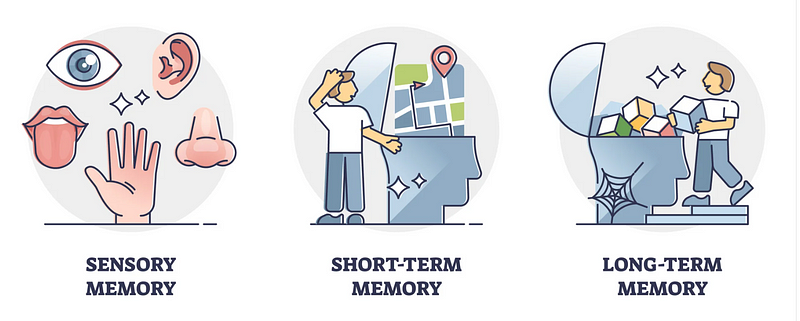Mastering Memory: Enhance Your Learning with Three Memory Types
Written on
Understanding Memory: The Three Types
Have you ever been able to recall the scent of summer rain from your childhood? This ability can be traced back to the structure of your memory, which is typically divided into three categories: sensory, short-term, and long-term memory. In this article, we will delve into these three types of memory and provide practical strategies to enhance your learning experience.
Exploring the Three Memory Types
Since 2018, my journey into neuroscience, brain research, and cognitive psychology has been driven by a passion for helping individuals learn more effectively. I have shared various guides on how to apply learning science to reading, online courses, and knowledge management. A particularly intriguing area for me is memory, as it serves as the foundation of our learning process. Memory can be grouped into three essential types: Sensory Memory, Short-term Memory, and Long-term Memory.

Sensory Memory
This is the most transient form of memory, allowing individuals to retain fleeting impressions of sensory information after the original stimuli have ceased. For instance, visual sensory memory enables you to remember the appearance of an object after only a brief glance. Similarly, echoic sensory memory helps you recall sounds and words you've just heard, even after they have faded away. Moreover, olfactory sensory memory can trigger vivid memories linked to a scent after just a whiff of a fragrance.
Short-term Memory (Working Memory)
Located in the prefrontal cortex, this type of memory temporarily holds information for processing. It is activated when you consciously think about something in the present moment, generally retaining information for around 15 to 30 seconds—like a phone number or items on your grocery list. Interestingly, research has produced varying estimates of how many items working memory can hold simultaneously. Early studies suggested it was about seven, but later research indicated a range between two to six ideas.
Long-Term Memory
Long-term memory resides in the cerebral cortex and refers to the storage of information for extended periods. It boasts a much greater capacity than short-term memory and can retain information indefinitely. Long-term memory is typically categorized into two types:
- Implicit (Procedural) Memory: This involves subconscious memories, such as learned skills and behaviors. For example, riding a bicycle or catching a ball can be performed without conscious thought.
- Explicit (Declarative) Memory: This encompasses facts or memories of past events that can be consciously recalled. Examples include naming countries in Europe (semantic memories), recounting a recent vacation (episodic memories), or describing your route home from work (spatial memories).
Strategies to Boost Your Learning
Continue Learning, Even When Your Short-term Memory is Full
Each memory type plays a unique role in our cognitive functions. At times, your brain may feel "full," but this is not due to cognitive overload; rather, it’s your short-term memory reaching its capacity.
Enhance Your Long-term Memory
Long-term memory provides a solution to the limitations of short-term memory. Unlike short-term memory, long-term memory retains information over time. To become a more proficient learner, focus on strategies that facilitate the transfer of information from short-term to long-term memory. Engaging in active retrieval, rather than passive consumption of content, is essential for this transition.
In conclusion, understanding the various types of memory can shed light on how your mind operates. From rapid sensory impressions to short-term holding and enduring storage, each memory type plays a crucial role in learning and retention. By honing in on techniques that enhance long-term memory, such as active recall, you can improve your problem-solving abilities and boost creativity.
Want to feel inspired and gain deeper insights into effective learning?
Subscribe for free to my Learn Letter, where each Wednesday, you'll receive evidence-based tools and resources to enrich your learning journey. If you're eager to explore more brain-expanding practices, consider signing up for the waitlist for my upcoming book.
Chapter 2: The Science of Memory
In this video, "The Three Systems of Memory," you will learn how sensory, short-term, and long-term memory work together to facilitate learning and recall.
Chapter 3: Memory Types in Depth
This video, "Types of Memory | Short Term & Working Memory, Long Term Memory (Explicit and Implicit)," explores the different categories of memory and their implications for learning.